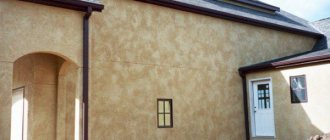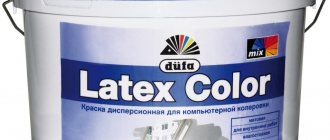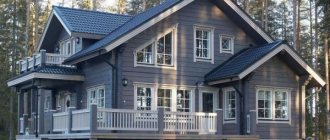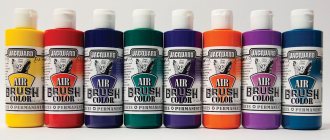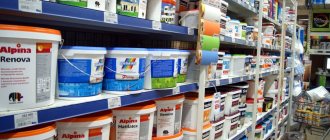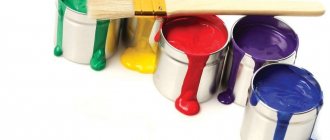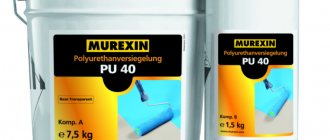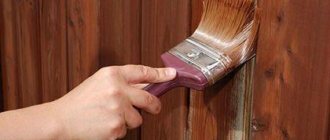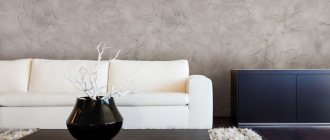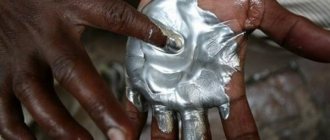Features of paintwork in winter
It is better to refrain from painting at temperatures of -5...+5 °C, since this range is considered unfavorable due to the formation of condensation. Moisture changes the properties of paintwork materials - the coating becomes of poor quality and does not last long.
Facade paints will take 2-3 times longer to dry in the cool season. You can improve the quality of the coating using a thermal gun. You can also attach film to scaffolding.
When choosing paintwork materials, you need to make sure that the composition is suitable for painting in frost. If the dye is not suitable for winter use, it will freeze. The quality of the paint also matters.
The temperature of the paint and varnish material must exceed 0 °C. If the composition cools more, the container containing it must be placed in a basin with preheated liquid.
Types of paint
There are several types of paints available to decorate and protect the facades of your home. Some of them are well known, some not so much. Basically the materials are of the following types:
- Vinyl paints. These coatings can also be hidden under another name - polyvinyl acetate bases. This is already an outdated type, which is diluted with water before facade work. When dry, the layers shrink, and over time, mold may appear on the facade.
- Latex bases. They can be acrylic or acrylic-silicate. This is a newer type, resists moisture well and retains color for a long time. The decorative qualities of this base are very high. Also, they have high hiding power. That is, with 1-2 layers you can get good results.
- Silicone paints. They can be made from different components and contain siloxane, organic silicon and other silicones. The resulting layer is very smooth and does not absorb water. The big advantage of this paint is that, without absorbing water from the outside, it releases it perfectly from the inside. That is, the house will thaw the moisture, and the paint will remove it.
- Lime paints are excellent for painting difficult areas such as foundations, since this coating is completely insensitive to water and susceptible to mold and rot.
- Cement materials. The coating composition is based on Portland cement; it has good vapor permeability, but tends to absorb water.
- Facades are also treated with antiseptics that contain pigments. Their temperature regime corresponds to paint and varnish.
There are also other types of paints, since modern production does not stand still. But there is simply no point in considering them all. In the vast majority of cases, the paints discussed in this list are chosen. Because they are available both for purchase and at a price.
Maximum temperature limits for paints
Before carrying out work, you need to make sure that the established temperature regime is suitable for the purchased paint.
Previously, the minimum temperature at which it was allowed to paint the walls of residential and commercial buildings was +5 ° C. Now, however, dyes are being produced that can be used at zero temperatures and even in severe frost, down to -30 ° C. The upper limit at which painting can be done is considered to be +40 °C.
What paints are used in winter
Enamels and primers that are used at subzero temperatures are varied. Their properties:
- do not freeze in the cold;
- suitable for different types of materials;
- can be operated at temperatures down to -10…-20 degrees;
- form an elastic layer;
- Dries faster compared to regular paint.
Water-based paints
This type of paint is most in demand in winter. The products of the companies Dufa and Batilith, Dulux and Tikkurila, which produce many types of corresponding paints and varnishes, are very popular. Good frost-resistant paints are produced by the German company Caparol. A number of manufacturers produce frost-resistant water-based paint AK-115, which can withstand temperatures down to -20 degrees below zero. Other known materials:
- Parade f20;
- Lakra;
- Alpa Façade;
- Brite Professional primer;
- Vincent Muralith F1.
Oil paints
Oil-based materials are almost never used now. Their properties are much inferior to water-based paints; their service life is no more than 2-3 years. The products need to be diluted with drying oil and special solvents. Only some paints marked PF, MA, GF are suitable for working in cold weather.
Recommendations for better drying
To make frost-resistant metal paints dry faster, you can use devices that heat the air over a short distance. Not only special devices are suitable, but also household appliances (for example, a hair dryer).
It is necessary to pre-prepare the surface. You will have to remove the previous coating from it. Then the metal product is processed with special devices.
Suitable:
- sandblasting machine;
- sandpaper.
If there are irregularities, use putty.
It will not work in rainy or snowy weather. Precipitation will prevent winter metal paint from drying.
You only need to work with dry and clean material. Dust, dirt and mold are removed with a brush.
If the work is carried out in an unheated room, you can speed up the drying process using a portable heater; the paint dries faster when exposed to heat.
Preparing a house for painting and the nuances of work
In general, the work involved in preparing houses for painting work is always the same. The surfaces of the façade must be thoroughly cleaned of dirt and dust. Surfaces that are infected with mold or rot must be sanded. The remaining surfaces of the facade can also be sanded.
This work will raise the wood fibers, and the adhesion to the paint composition will be better. Due to this, the paint layer will adhere more reliably to the wall, and it also reduces the risk of bubbles and an air gap between the house and the layer.
After sanding, it would be useful to coat the facade with a primer. This operation is performed at a temperature of no more than -10°C. At lower temperatures the primer loses its properties.
When painting work, it will be important to choose components from one manufacturer. That is, the material, solvent and primer must be selected from the same manufacturer. In this case, all the loaded qualities will correspond and perform the promised functions. When working in cold weather, it is better to use two packages of coloring composition.
Place one package in a warm place and work with the other. They need to be changed periodically, preferably once every half hour. Also, after work, the layer must be allowed to dry. In negative values this procedure takes longer. Therefore, it makes sense to apply a second layer 3-5 days after the first.
Frost-resistant paints for rust
Infrazim-Antikor is suitable for painting rusted structures. This paint is used in the range -20...+30 °C. Humidity should not exceed 80%. The composition is simultaneously a rust converter, a corrosion-preventing primer and an environmentally resistant decorative enamel. You can purchase glossy or matte paint. As for the palette, paintwork materials are available in white, gray, beige, cream, red, green, light green, light blue, blue, ocher, brown, yellow, orange, black and red-brown.
Primer enamel XB-0278 can be used for outdoor work at temperatures ranging from -10 to +25 °C. This product is applied to metal with rust and traces of scale that cannot be removed.
Primer-enamel for rust “Spetsnaz” is used to treat rusted steel and cast iron products in order to prevent the occurrence of corrosion. The composition will also protect the metal from aggressive gases and fumes during production. "Spetsnaz" can be used for repair painting of car parts. They work with paintwork materials at sub-zero temperatures (down to -10 °C).
Indoor painting work
Painting the inside of a house in cold weather is much easier than doing exterior work. But the specifics of painting must be taken into account.
Balcony
Painting a balcony or loggia in an apartment in winter may be required when selling to improve the surface of walls, ceilings, and floors. The most difficult thing is to paint a cold balcony - it is better to wait until the temperature is above zero and only then carry out painting work. If absolutely necessary, you can purchase paint that can withstand low temperatures, wait for a sunny day, make sure the walls of the loggia are warmed up sufficiently, and paint.
Painting is carried out only in the morning - the coating will dry faster due to heating by the sun's rays. If you have an outlet, you can place a heater on the insulated balcony, this will allow you to carry out the work efficiently. Acrylic water-based compositions are well suited for balconies - with their use you can avoid poisoning, they are environmentally friendly and odorless. Such paints increase the thermal insulation characteristics of walls, allow them to “breathe,” and fade and deteriorate very slowly. If there are parts made of plastic or metal on the balcony, it is better to coat them with varnish. The lining is coated with acrylic varnish.
Batteries
Painting a battery in winter has a number of features. To paint the radiator, you need to prepare a brush with metal bristles, a simple brush and a radiator brush with a long handle. You will also need sandpaper, a dust brush, and a knife. Be sure to purchase a metal primer, paint, and solvent. The basic composition must be suitable for radiators and contain anti-corrosion additives and be non-toxic. The best means are:
- acrylic;
- alkyd;
- water-dispersed;
- silicone;
- based on heat-resistant varnish;
- zinc.
How many degrees can such enamels withstand? They are designed for a standard temperature of +80 degrees. Some are available in aerosol form - sold in a can, and by spraying you can easily paint even the most difficult to reach places. It is better to remove the batteries for painting by turning off the water supply. If this is not possible, you should wait until the batteries are turned off in the spring. Hot batteries will be painted poorly and the coating will often swell. After cleaning the surface, it is primed and painted in 2 layers. Each layer must dry completely.
Window
Painting wooden windows in frosty weather outside is undesirable, like other wood products. Only the use of heat guns will make it possible to dry the product well, but the labor intensity of the work will increase significantly. The inside is painted in the same way as it is done in warm weather. The old paint must be removed, the surface primed, and then a suitable composition must be applied. Plastic windows can also be painted using special paints if you need to update their color.
The best winter coatings for metal
KO-870 enamel is used even in severe frost – down to -30 °C. It is used to paint metal structures exposed to temperatures in the range of +60...+600 °C. The dye is resistant to a number of aggressive substances (oil, saline solutions).
Primer enamel "SpetsKor" is resistant to moisture, ultraviolet rays and temperatures down to -60 °C. Does not allow air or steam to pass through. Has a hammer effect (hides defects in products that are being painted).
Organosilicate composition OS-12-03 will prevent corrosion that occurs due to the unfavorable influence of the surrounding atmosphere. Applicable at -30…+40 °C.
Facade enamel KO-174 is used not only for protecting metal products, but also for painting facades. Suitable for painting concrete, brick products, plastered walls, floors, ceilings. Well protects metal from moisture and air. The composition must be applied at a temperature of -30…+40 °C.
HB-785 enamel is used in multi-layer painting. It is used to treat plastered structures. Paintwork protects products from the adverse effects of gaseous substances, acid, salt and alkaline solutions, if the temperature does not rise above +60 °C. The composition can be applied at +35…-10 °C.
Temperature conditions when applying impregnations and sealants
Why is it important to monitor the temperature when treating facades with impregnations and sealing a wooden house?
Most package labels provide a recommended temperature range for the application of a given product, but there are times when you may need to know a little more about the application temperature in order to properly plan or complete a job. In some cases, you can take steps to help cope with extreme hot or cold temperatures. It is important to keep in mind that in this case we are dealing with surface temperature, not air temperature . It is necessary to take into account the temperature of the logs or timber directly, and not the temperature of the thermometer hanging outside the window.
Articles on this topic:
Impregnation of wood at low temperatures
Frost resistance of impregnations and sealants
More details about the product
Capture + Cascade wood protection and painting system
Colored translucent stain impregnation and topcoat
The coating for a wooden house has a unique formula that allows the coating to expand and contract with the wood. Guarantees no peeling, delamination or cracking of the coating. Emphasizes the wood pattern. Protects against mold and ultraviolet radiation. Made and Packaged in the USA .
Cleaning and restoring products for wood
Recommended range:
Log Wash - 4 to 32 °C Wood ReNew - 10 to 32 °C
Wood cleaners and brighteners work better in warm conditions than in cold conditions. Of the two products listed above, Log Wash is the least susceptible to freezing temperatures. Cleaning with Log Wash, even in near freezing temperatures, will still be effective. On the other hand, using Wood ReNew on a cold surface may not give the desired result, even if the exposure time is extended to several hours. The principle of operation of this product is based on chemical reactions, and the rate of reactions decreases significantly when the surface temperature approaches 0 °C.
If any of these products are allowed to dry out, they will stop working. Therefore, in hot weather, the treated surface should be periodically moistened.
Lifeline wood finishes
Recommended range:
All Lifeline coatings - 4 to 32 °C Advance - 4 to 32 °C Log End Seal - 4 to 32 °C
What will happen in early spring and late autumn if, a few hours after applying the topcoat, the temperature on the surface of the log facade suddenly drops below zero? As practice shows, exposure to low temperatures that occurs after application and formation of the film does not in any way affect the appearance or quality of the finish. Limitations on surface temperature relate to the process of applying impregnation itself, and not to the temperature that affects the treated surface after painting.
All Lifeline wood coatings can in principle be used where necessary at wood substrate temperatures of 1.5 °C, but best at 4 °C and above. The main problem at these temperatures is that it will take quite a long time, perhaps more than a day, for the sealer to dry enough to confidently apply a second coat of Lifeline Exterior or Ultra-2 topcoat. If you do not wait until it dries completely, the resulting film may form into lumps when blending the coating using the reverse brush stroke method.
But what you absolutely cannot do is apply impregnation to logs and beams at subzero surface temperatures. Under such conditions, the coating may not stick to the wood at all. Conversely, at high temperatures, too short a drying time can become a problem: in this case, the film may dry out so quickly that it cannot be blended and the coating will have an uneven shade.
The application of Lifeline Advance transparent façade coating to wooden substrates has some special features. At low temperatures it takes longer to dry, therefore remaining opaque longer. In high temperatures, drying too quickly makes blending difficult.
Although the surface temperature range on these product labels ranges from 4 to 32 degrees Celsius, the most favorable temperatures for the easiest and most effective application are between 10 to 27 degrees Celsius.
The most sensitive to cold weather is the sealant coating used to protect the ends of logs and beams, Log End Seal. Being somewhat sensitive to humidity until it fully cures (and cold slows down this process), Log End Seal will take a long time to become transparent and will remain whitish for some time, depending on the thickness of the layer. When warm and dry weather arrives, this defect will disappear, the layer will become transparent and remain so. It is recommended to apply a topcoat of Lifeline Advance over the Log End Seal to protect against contamination.
Sealants
Recommended range:
Perma-Chink - above 4 °C Energy Seal - above 4 °C Check Mate 2 - from 4 to 32 °C
When applying any of our log sealers in cold weather, there are two main factors to consider: the temperature of the log and the temperature of the material being applied. As long as the wooden base is dry and not overcooled, the appearance and technical characteristics of the sealant are not threatened. However, as the temperature decreases, the viscosity of the sealant increases. This immediately becomes noticeable when trying to squeeze the material out of the tube, as well as when filling the gun from a bucket. Cold sealant is harder to smooth with a spatula. Therefore, if you store our acrylic sealants at a temperature of 10 to 21 ° C, it will be much easier to work with them.
The only effect that negative temperatures have on an already applied layer of sealant is an increase in its polymerization time. While Energy Seal or Perma-Chink takes a few weeks to fully cure in the summer, it may take several months to complete the process in the winter.
Also, regardless of the time of year, it is recommended to never apply sealant in direct sunlight. Even on a cold day, direct sun can heat the surface so much that the sealant layer will lose water unevenly and bubbles may appear. In very hot weather, this can happen if the sun quickly heats up the wall of the log house immediately after applying sealing compounds, especially if the wood is fresh and damp. Drape the sealant-treated building façade until the sealant has sufficiently cured.
Hot weather can reduce the time it takes to iron out a seam to just a few minutes. If masking tape is used to protect the surface around the joint, it must be removed before the sealant begins to dry. Otherwise, part of the sealant will be removed along with the tape. Although we do not indicate an upper limit on the Perma-Chink and Energy Seal labels, we do not recommend using them above 32°C.
Another essential tool for applying wood sealant
Nowadays, there are no obstacles to accurately measuring surface temperature. An infrared thermometer will help you with this. Until recently, this was an expensive device, but now it is quite affordable, and every contractor involved in insulating wooden houses must have it. Be sure to purchase this useful device if you decide to seal and apply impregnations yourself.
We hope these tips will help you avoid mistakes when using high-tech materials from Perma-Chink Systems and the results will delight you for many years, like thousands of other homeowners around the world!
Is it possible to paint the facade with water-based paint?
Finishing the facade is not just a decorative process. It allows you to enhance the protection of your home from the effects of environmental climate. Water-based products used for exterior finishing can cope with the task.
An ordinary water-based emulsion will not work; it is better to give preference to a product based on silicone or acrylic. These are universal mixtures with a long service life. The special coating can last 7-11 years, subject to proper use and compliance with finishing technology.
Application
When the wall of a building is located on the shady, northern side, dampness and mold may appear there. So, before painting, you should use a protective primer that has an antifungal effect.
